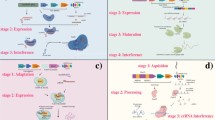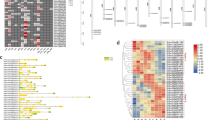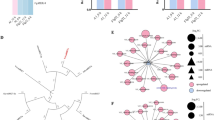Abstract
Camptotheca acuminata is the major plant for the production of camptothecin (CPT), an important anti-cancer drug used for the treatment of various cancers throughout the world. The low accumulation of CPT in plants limited its supply in the market and led to urgent need of promoting its accumulation by means of plant metabolic engineering, which relied on deep understanding of CPT biosynthesis pathway. However, missing of most of pathway genes restricted the attempts for regulating CPT biosynthesis. To unveil the CPT biosynthesis pathway, many efforts have been done for pathway gene identification and the application of large-scale RNA-sequencing technique accelerated screening of candidate genes which could be involved in CPT biosynthesis. To identify the function of these candidate genes in planta, it needs to develop an effective approach, such as virus-induced gene silencing (VIGS) in C. acuminata. In this work, a Tobacco Rattle Virus-based VIGS method was developed and the application of this method successfully silenced the expression of four known genes involved in the early steps of CPT biosynthesis and resulted in clear decrease of CPT and 10-hydroxycamptothecin (10-HCPT) accumulation. This VIGS approach could be further applied to functional identification of candidate genes to elucidate CPT biosynthesis in C. acuminata.





Similar content being viewed by others
References
Baulcombe DC (1999) Fast forward genetics based on virus-induced gene silencing. Curr Opin Plant Biol 2:109–113
Burnett RT, Maldonado-Mendoza IE, Mcknight TD, Nessler CL (1993) Expression of a 3-hydroxy-3-methylglutaryl coenzyme a reductase cene from Camptotheca acuminata is differentially regulated by wounding and methyl jasmonate. Plant Physiol 103:41–48
Di Stilio VS, Kumar RA, Oddone AM, Tolkin TR, Salles P, McCarty K (2010) Virus-induced gene silencing as a tool for comparative functional studies in Thalictrum. PLoS One 5:e12064
Dinesh-Kumar SP, Anandalakshmi R, Marathe R, Schiff M, Liu Y (2003) Virus-induced gene silencing. In: Grotewold E (ed) Plant functional genomics. Humana Press, New York, pp 287–293
Góngora-Castillo E, Childs KL, Fedewa G, Hamilton JP, Liscombe DK, Magallanes-Lundback M, Mandadi KK, Nims E, Runguphan W, Vaillancourt B, Varbanova-Herde M, DellaPenna D, McKnight TD, O’Connor S, Buell CR (2012) Development of transcriptomic resources for interrogating the biosynthesis of monoterpene indole alkaloids in medicinal plant species. PLoS One 7:e52506
Gould B, Kramer EM (2007) Virus-induced gene silencing as a tool for functional analyses in the emerging model plant Aquilegia (columbine, Ranunculaceae). Plant Methods 3:6
Hileman LC, Drea S, Martino G, Litt A, Irish VF (2005) Virus-induced gene silencing is an effective tool for assaying gene function in the basal eudicot species Papaver somniferum (opium poppy). Plant J 44:334–341
Hsiang YH, Hertzberg R, Hecht S, Liu LF (1985) Camptothecin induces protein-linked DNA breaks via mammalian DNA topoisomerase I. J Biol Chem 260:14873–14878
Itkin M, Heinig U, Tzfadia O, Bhide AJ, Shinde B, Cardenas PD, Bocobza SE, Unger T, Malitsky S, Finkers R, Tikunov Y, Bovy A, Chikate Y, Singh P, Rogachev I, Beekwilder J, Giri AP, Aharoni A (2013) Biosynthesis of antinutritional alkaloids in solanaceous crops is mediated by clustered genes. Scienc 341:175–179
Jin H, Axtell M, Dahlbeck D, Ekwenna O, Zhang S, Staskawicz B, Baker B (2002) NPK1, an MEKK1-like mitogen-activated protein kinase kinase kinase, regulates innate immunity and development in plants. Dev Cell 3:291–297
Kai G, Xu H, Zhou C, Liao P, Xiao J, Luo X, You L, Zhang L (2011) Metabolic engineering tanshinone biosynthetic pathway in Salvia miltiorrhiza hairy root cultures. Metab Eng 13:319–327
Kai G, Li S, Wang W, Lu Y, Wang J, Liao P, Cui L (2013) Molecular cloning and expression analysis of a new gene encoding 3-hydroxy-3-methylglutaryl-CoA synthase from Camptotheca acuminata. Russ J Plant Physiol 60:131–138
Kai G, Teng X, Cui L, Li S, Hao X, Shi M, Yan B (2014) Effect of three plant hormone elicitors on the camptothecin accumulation and gene transcript profiling in Camptotheca acuminata seedlings. Int J Sci 3:86–95
Krishnan A, Mahadevan C, Mani T, Sakuntala M (2015) Virus-induced gene silencing (VIGS) for elucidation of pathogen defense role of serine/threonine protein kinase in the non-model plant Piper colubrinum Link. Plant Cell, Tissue Organ Cult 122:269–283
Li R, Reed DW, Liu E, Nowak J, Pelcher LE, Page JE, Covello PS (2006) Functional genomic analysis of alkaloid biosynthesis in Hyoscyamus niger reveals a cytochrome P450 involved in littorine rearrangement. Chem Biol 13:513–520
Liscombe DK, O’Connor SE (2011) A virus-induced gene silencing approach to understanding alkaloid metabolism in Catharanthus roseus. Phytochemistry 72:1969–1977
Liu YL, Schiff M, Marathe R, Dinesh-Kumar SP (2002a) Tobacco Rar1, EDS1 and NPR1/NIM1 like genes are required for N-mediated resistance to tobacco mosaic virus. Plant J 30:415–429
Liu YL, Schiff M, Dinesh-Kumar SP (2002b) Virus-induced gene silencing in tomato. Plant J 31:777–786
Lo´pez-Meyer M, Nessler CL (1997) Tryptophan decarboxylase is encoded by two autonomously regulated genes in Camptotheca acuminata which are differentially expressed during development and stress. Plant J 11:1167–1175
Lu H, McKnight TD (1999) Tissue-specific expression of the betasubunit of tryptophan synthase in Camptotheca acuminata, an indole alkaloid-producing plant. Plant Physiol 120:43–52
Lu H, Gorman E, McKnight TD (2005) Molecular characterization of two anthranilate synthase alpha subunit genes in Camptotheca acuminata. Planta 221:352–360
Maldonado-Mendoza IE, Vincent RM, Nessler CL (1997) Molecular characterization of three differentially expressed members of the Camptotheca acuminata 3-hydroxy-3-methylglutaryl CoA reductase (HMGR) gene family. Plant Mol Biol 34:781–790
Pan X, Chen M, Liu Y, Wang Q, Zeng L, Li L, Liao Z (2008) A new isopentenyl diphosphate isomerase gene from Camptotheca acuminata: cloning, characterization andfunctional expression in Escherichia coli. DNA Seq 19:98–105
Peele C, Jordan CV, Muangsan N, Turnage M, Egelkrout E, Eagle P, Hanley-Bowdoin L, Robertson D (2001) Silencing of a meristematic gene using geminivirus-derived vectors. Plant J 27:357–366
Ruan J, Zhang J, Li M, Zhu Y, Sun L, Jin H, Su H (2014) Dependence of UV-B-induced camptothecin production on nitrate reductase-mediated nitric oxide signaling in Camptotheca acuminata suspension cell cultures. Plant Cell, Tissue Organ Cult 118:269–278
Runguphan W, Maresh JJ, O’Connor SE (2009) Silencing of tryptamine biosynthesis for production of nonnatural alkaloids in plant culture. Proc Natl Acad Sci 106:13673–13678
Salim V, Yu F, Altarejos J, De Luca V (2013) Virus induced gene silencing identifies Catharanthus roseus 7-deoxyloganic acid-7-hydroxylase, a step in iridoid and monoterpene indole alkaloid biosynthesis. Plant J 76:754–765
Salim V, Wiens B, Masada-Atsumi S, Yu F, De Luca V (2014) 7-Deoxyloganetic acid synthase catalyzes a key 3 step oxidation to form 7-deoxyloganetic acid in Catharanthus roseus iridoid biosynthesis. Phytochemistry 101:23–31
Sun Y, Luo H, Sun C, Song J, Niu Y, Zhu Y, Dong L, Lv A, Tramontano E, Chen S (2011) Pyrosequencing of the Camptotheca acuminata transcriptome reveals putative genes involved in camptothecin biosynthesis and transport. BMC Genom 12:533
Tian J, Cheng L, Han Z, Yao Y (2015) Tobacco rattle virus mediated gene silencing in strawberry plants. Plant Cell, Tissue Organ Cult 120:1131–1138
Valletta A, Trainotti L, Santamaria AR, Psaqua G (2010) Cell-specific expression of tryptophan decarboxylase and 10-hydroxygeraniol oxidoreductase, key genes involved in camptothecin biosynthesis in Camptotheca acuminata Decne (Nyssaceae). BMC Plant Biol 10:1–27
Wang Q, Pi Y, Hou R, Jiang K, Huang Z, Hsieh MS, Sun X, Tang K (2008) Molecular cloning and characterization of 1-hydroxy-2-methyl-2-(E)-butenyl 4-diphosphate reductase (CaHDR) from Camptotheca acuminata and its functional identification in Escherichia coli. BMB Rep 41:112–118
Wege S, Scholz A, Gleissberg S, Becker A (2007) Highly efficient virus-induced gene silencing (VIGS) in California poppy (Eschscholzia californica): an evaluation of VIGS as a strategy to obtain functional data from non-model plants. Ann Bot 100:641–649
Yao HY, Gong YF, Zuo KJ, Ling H, Qiu ChX, Zhang Fi, Wang YC, Pi Y, Liu X, Sun XF, Tang KX (2008) Molecular cloning, expression profiling and functional analysis of a DXR gene encoding 1-deoxy-D-xylulose 5-phosphate reductoisomerase from Camptotheca acuminata. Plant Physiol 165:203–213
Acknowledgments
This work was funded by National Natural Science Foundation of China (Grant No. 31570303) and Natural Science Foundation of Liaoning Province of China (Grant No. 2015020659).
Author information
Authors and Affiliations
Corresponding authors
Rights and permissions
About this article
Cite this article
Jin, Z., Yan, T., Chang, C. et al. Application of virus-induced gene silencing approach in Camptotheca acuminata . Plant Cell Tiss Organ Cult 126, 533–540 (2016). https://doi.org/10.1007/s11240-016-1022-5
Received:
Accepted:
Published:
Issue Date:
DOI: https://doi.org/10.1007/s11240-016-1022-5




